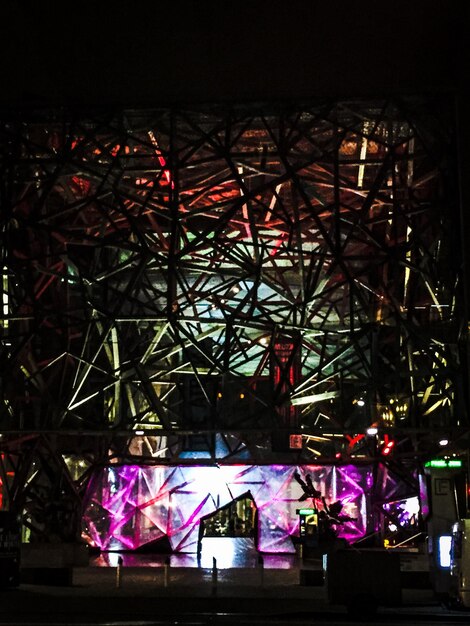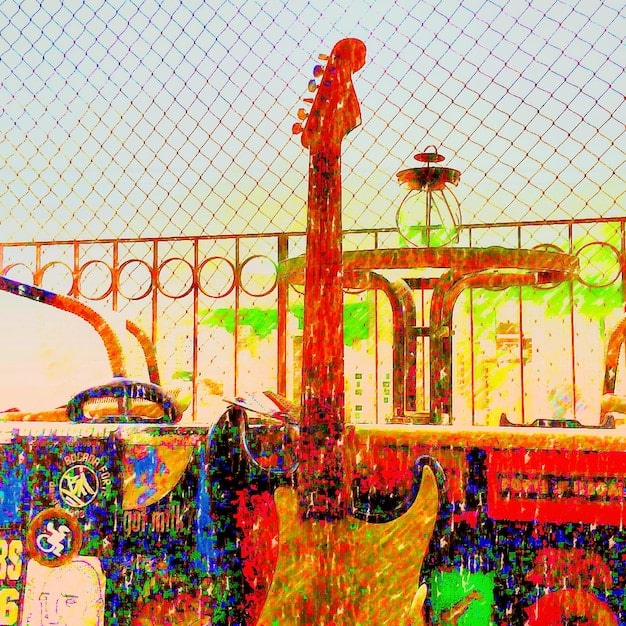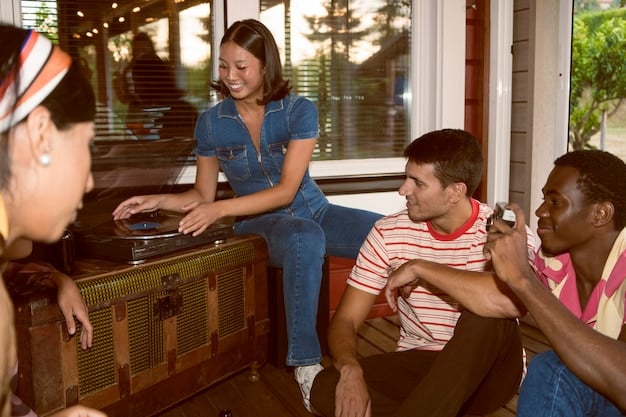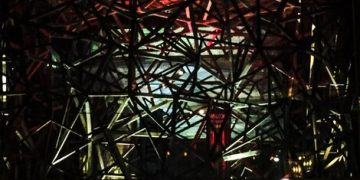US Underground Music: 2025 Evolution & 3 Key Trends

The US underground music scene in 2025 is undergoing significant transformations, driven by technological innovations, a renewed focus on independent artist empowerment, and a dynamic blending of genres and cultural influences, creating a more diverse and accessible landscape.
The soundscape of the United States is in constant flux, but nowhere is this more evident than in its underground music scene. As we step into 2025, a fascinating evolution is unfolding, challenging established norms and forging new paths for artists and audiences alike. This article explores how is the US underground music scene evolving in 2025? Discover 3 key trends that are reshaping its very core.
The digital frontier: decentralization and direct artist-fan connections
The digital revolution has been a slow burn in music, but in 2025, its impact on the underground scene is undeniable. We’re seeing a profound shift from centralized distribution to decentralized ecosystems, fundamentally reshaping how artists connect with their audience and monetize their craft. This isn’t just about streaming platform alternatives; it’s about artists taking full control.
Beyond traditional platforms: web3 and independent ecosystems
The rise of Web3 technologies is no longer a niche conversation but a tangible reality within the underground. Blockchain-based platforms, offering verifiable ownership and smart contracts, are empowering artists to distribute their music directly, manage royalties transparently, and even build tokenized communities around their work. This bypasses intermediaries, ensuring a larger share of revenue returns to the creators.
* NFTs as direct patronage: Non-Fungible Tokens (NFTs) are evolving beyond speculative art, becoming a viable model for artist funding. Fans purchase unique digital assets—a song, an album, exclusive behind-the-scenes content—directly supporting artists and gaining tangible benefits like access to private shows or exclusive merchandise.
* Decentralized autonomous organizations (DAOs): Music DAOs are emerging, where fans and artists collectively govern projects, fund new releases, and even make creative decisions. This fosters a sense of co-ownership and collective investment in the artistic process, blurring the lines between creator and consumer.
* Micro-streaming and fan-funded initiatives: Smaller, artist-centric streaming platforms are gaining traction, often with more equitable payout structures. Alongside this, fan-funding models, facilitated by new digital tools, allow dedicated listeners to directly commission or support specific projects, bringing niche genres and experimental sounds to life.
This new digital landscape is not without its challenges, including issues of discoverability and technical literacy. However, the sheer potential for artistic freedom and financial independence is driving a rapid adoption among forward-thinking underground artists. They are finding innovative ways to bypass the gatekeepers and build sustainable careers on their own terms. It’s creating a more level playing field where talent and innovation can truly thrive, unburdened by traditional industry constraints.
The resurgence of DIY culture: community and physical spaces
While digital advancements are propelling the underground forward, 2025 also marks a powerful resurgence of DIY (Do-It-Yourself) culture, intertwining with a renewed appreciation for physical spaces and localized communities. This isn’t a rejection of the digital, but rather a complementary movement that emphasizes authentic, tangible experiences and grassroots organization.
Reclaiming local scenes: pop-ups, collectives, and intimate venues
The pandemic years highlighted the fragility of traditional music venues, leading many artists and promoters to rethink performance spaces. In 2025, we’re seeing an explosion of pop-up shows in unexpected locations—warehouses, art galleries, converted retail spaces, and even private residences. These temporary venues foster an intimate atmosphere, allowing for more experimental performances and a closer connection between artists and their audience.
* Artist-run collectives: Musical collectives are flourishing, pooling resources and expertise to create their own events, labels, and creative hubs. These collectives are instrumental in curating unique experiences and nurturing local talent, often operating outside conventional commercial pressures.
* Hybrid spaces: Venues are becoming multi-functional, combining elements of performance spaces, art installations, community centers, and even cafes. This ensures greater sustainability for these spaces and offers diverse opportunities for artistic expression beyond just live music, fostering a holistic cultural environment.
* Grassroots promotion and word-of-mouth: While digital tools are used for initial outreach, the success of these DIY endeavors often relies on authentic word-of-mouth promotion within tight-knit communities. Recommendations from trusted sources and a shared discovery of hidden gems become paramount, reinforcing the importance of genuine connection.
This return to grassroots organizing and community-centric approaches creates a vibrant counter-narrative to the sprawling digital world. It underscores the human element of music—the shared experience, the collective energy, and the power of local scenes to nurture innovation and creativity. It’s about building strong, resilient networks from the ground up, proving that the most impactful cultural shifts often begin at the local level. These spaces cultivate a unique energy that cannot be replicated online.

Genre-bending and cultural fusion: A melting pot of sound
The year 2025 sees the US underground music scene as a true sonic melting pot, where traditional genre boundaries are not just blurring but effectively dissolving. Artists are fearlessly experimenting, drawing inspiration from a vast array of cultures, histories, and technological advancements, creating sounds that defy easy categorization and reflect a globally interconnected world.
Beyond definitions: new sonic territories and cross-cultural collaborations
The rigid categorizations of pop, rock, electronic, or hip-hop are increasingly irrelevant. Underground artists are crafting hybrid genres, seamlessly weaving elements from disparate musical traditions. This fusion is often driven by a genuine curiosity and respect for diverse cultural expressions, leading to incredibly rich and innovative soundscapes.
* Global influences: Artists are incorporating sounds, rhythms, and instrumentation from around the world, reflecting the diverse demographics of the US itself. We’re hearing traditional African polyrhythms fused with electronic beats, Latin American melodic structures blending with indie rock, and Asian folk elements integrated into experimental jazz.
* Technological integration: The accessibility of advanced digital audio workstations (DAWs) and virtual instruments allows artists to experiment with a vast palette of sounds, from hyper-real simulations of traditional instruments to entirely synthetic, futuristic textures. AI-assisted composition tools are also beginning to play a role, pushing creative boundaries.
* Interdisciplinary art forms: Music is increasingly being presented as part of a larger artistic experience, integrating with visual art, dance, spoken word, and immersive theater. Live performances become multi-sensory events, blurring the lines between different artistic disciplines and offering audiences a more holistic engagement.
This pervasive genre-bending and cultural fusion is not merely a trend; it’s a fundamental characteristic of the 2025 underground. It reflects a generation of artists who are unafraid to challenge convention, who view musical traditions as a rich source for innovation, and who are creating a sound that is truly reflective of a diverse, interconnected, and constantly evolving world. This dynamic interaction fosters an environment where innovation is the norm.
The evolving role of discovery and curation in a saturated landscape
With the explosion of independent artists and diverse musical offerings, the challenge of discovery and effective curation becomes paramount in 2025. The underground scene, while embracing decentralization, also grapples with the sheer volume of content available, making it harder for unique voices to cut through the noise. This has led to the emergence of new gatekeepers—not necessarily traditional industry figures, but influential tastemakers, specialized algorithms, and community-driven platforms.
New avenues for finding new sounds: niche algorithms and human touch
While major streaming platforms often prioritize mainstream sounds, the underground thrives on more nuanced discovery methods. AI and machine learning are playing an increasingly sophisticated role, not just in recommending music based on user habits, but in identifying emerging patterns, cross-referencing niche subgenres, and even predicting sonic trends. However, this is largely complemented by a vital human element.
* Specialized music blogs and independent curators: Far from being obsolete, independent music blogs and online zines focused on specific genres or local scenes are more influential than ever. Their detailed reviews, interviews, and deep dives provide context and credibility that algorithms alone cannot replicate. These platforms are often the first to champion truly innovative artists.
* Community-driven platforms and forums: Online communities, from dedicated subreddits to private Discord servers, serve as vital hubs for discovery. Members actively share, discuss, and champion new music, acting as collective curators. This peer-to-peer recommendation system fosters trust and introduces listeners to sounds they might not find through conventional means.
* Live show experiences as discovery tools: Despite the digital focus, attending live underground shows remains a crucial method of discovery. The shared experience, the energy of a performance, and the opportunity to interact with artists directly create an unparalleled connection. Many listeners actively seek out smaller, less-known venues specifically to unearth new talent before they break into wider recognition.
The balance between algorithmic efficiency and human intuition is delicate. Effective discovery in 2025 requires both. Algorithms can surface a vast pool of potential tracks, but it’s the discerning ear of a passionate curator or the shared enthusiasm of a community that truly elevates an artist and helps them gain traction within the diverse tapestry of the underground scene. This interplay ensures that true innovation doesn’t get lost in the noise.

Sustainability and social consciousness: Artists as agents of change
In 2025, the US underground music scene is increasingly characterized by a strong undercurrent of social consciousness and a commitment to sustainability. Artists are not just creating music; they are actively engaging with pressing societal issues, using their platforms for advocacy, and adopting environmentally friendly practices in their creative and touring endeavors. This reflects a broader shift towards purposeful artistry.
Music with a message: activism, ethics, and environmental responsibility
Many underground artists view their work as a vehicle for change, addressing themes of social justice, environmental degradation, political disenfranchisement, and mental health within their lyrics, visuals, and public statements. This isn’t just about protest songs; it’s about embedding these concerns into the very fabric of their artistic identity.
* Advocacy and community engagement: Artists are partnering with non-profits, participating in benefit concerts, and using their social media presence to raise awareness and funds for various causes. They often foster direct engagement with local communities, lending their voice to community organizing efforts and grassroots movements.
* Ethical touring and production: There’s a growing awareness of the environmental impact of touring and merchandise production. Artists are exploring greener travel options, minimizing waste at shows, choosing sustainable materials for vinyl and merch, and even offsetting their carbon footprint. Small-batch, eco-conscious production is becoming a hallmark.
* Inclusive and safe spaces: The underground scene is making concerted efforts to be more inclusive and create safer spaces for all, particularly marginalized communities. This includes active measures against discrimination, harassment, and promoting diversity in line-ups, staff, and audience. There’s a strong emphasis on fostering environments where everyone feels welcome and respected.
This commitment to sustainability and social consciousness is not just a trend but a defining characteristic of many artists in the 2025 underground. It reflects a generation that is acutely aware of global challenges and sees music not merely as entertainment, but as a powerful tool for expression, connection, and ultimately, for fostering positive change in the world. They are building a scene that is both sonically groundbreaking and ethically grounded, demonstrating that art can indeed drive societal evolution.
The interplay of mainstream and underground: symbiotic influences
While the underground music scene prides itself on its distinctiveness and avant-garde nature, 2025 witnesses an increasingly intricate and often symbiotic relationship with the mainstream. The boundaries are far from rigid, with influences flowing in both directions, shaping the broader musical landscape in fascinating ways. This dynamic interaction ensures constant innovation on both sides of the spectrum.
From the fringes to popularity: inspiration and adaptation
The underground has always been a fertile ground for new sounds, styles, and artistic movements. What starts as experimental or niche in the underground often finds its way into mainstream consciousness, sometimes directly through breakout artists, and other times through subtle adoption of sounds and aesthetics by more commercially oriented acts. This process is accelerated in the digital age.
* Sound diffusion: Unique production techniques, synthesizers, vocal styles, or rhythmic patterns that originate in underground electronic, hip-hop, or indie scenes eventually permeate mainstream pop and R&B. Major producers and artists often listen to the underground for fresh ideas and inspiration, integrating these elements into their own work.
* Aesthetic influence: Fashion, visual art, and thematic concerns first championed in the underground frequently inform mainstream culture. The DIY ethos, anti-establishment leanings, or specific visual styles from underground zines and album art can subtly influence visual artists and stylists working with mainstream acts.
* Underground artists gaining broader recognition: While not the primary goal for many, some underground artists achieve wider acclaim without fully compromising their artistic integrity. This often happens through critical praise, viral moments, or strategic collaborations that maintain authenticity while expanding their reach. This allows their unique perspectives to inform a broader audience.
Conversely, the mainstream also influences the underground, albeit in different ways. The sheer resource availability and technological advancements in mainstream production can sometimes inspire underground artists to push their own sonic boundaries, adapting techniques to their independent contexts. Furthermore, mainstream discussions around music often bring new listeners into awareness of underground genres, sparking curiosity and directing them towards less-explored sounds. This constant exchange ensures that both spheres remain vibrant and relevant.
| Key Point | Brief Description |
|---|---|
| 🔗 Digital Decentralization | Artists leverage Web3 and independent platforms for direct distribution and fan connection. |
| 🛠️ DIY Culture Resurgence | Focus on pop-up venues, artist collectives, and community-driven events. |
| 🌐 Genre-Bending & Fusion | Unprecedented blending of styles and global influences, creating hybrid sounds. |
| 🌱 Social Consciousness | Artists prioritize activism, ethical practices, and inclusivity within the scene. |
Frequently Asked Questions
▼
In 2025, NFTs (Non-Fungible Tokens) are used in the underground music scene primarily as a direct patronage model. Artists offer unique digital assets like songs, albums, or exclusive content as NFTs, allowing fans to directly support them financially. This fosters a closer artist-fan relationship and provides artists with a more equitable revenue stream, bypassing traditional intermediaries and enabling creative freedom for niche projects and experimental works.
▼
DIY culture is leading to a resurgence of diverse, unconventional live music spaces in the US underground. Instead of relying solely on traditional venues, artists and collectives are organizing pop-up shows in unexpected locations like warehouses, art galleries, and even intimate private settings. This approach fosters closer artist-audience connections and offers more freedom for experimental performances, creating unique experiences that prioritize community and artistic expression over commercial viability.
▼
In 2025, traditional music genres are largely irrelevant within the US underground scene. Artists are fearlessly engaging in extensive genre-bending and cultural fusion, creating hybrid sounds that defy easy categorization. This trend is driven by global influences, technological advancements, and a desire to experiment. The result is a vibrant melting pot of sounds, where elements from disparate musical traditions are seamlessly woven together, reflecting a globally interconnected and diverse artistic landscape that constantly evolves beyond rigid labels and definitions.
▼
Social consciousness is a fundamental aspect of the US underground music scene in 2025. Many artists use their platforms to advocate for social justice, environmental sustainability, and ethical practices. This includes incorporating activist themes into their music and visuals, exploring eco-friendly touring and production methods, and actively creating inclusive and safe spaces at events. This commitment reflects a broader generational ethos that views music as a powerful tool for driving positive societal change and addressing critical global issues with authenticity.
▼
Underground artists primarily gain broader recognition in 2025 through a combination of niche algorithms, independent curators, and community-driven platforms. While critical acclaim and word-of-mouth remain crucial, specialized music blogs, online forums, and dedicated subreddits are vital for discovery. Occasionally, artists break into wider recognition through viral moments or strategic collaborations, but the emphasis remains on organic growth within specific communities, allowing their unique sounds to resonate with an ever-expanding, discerning audience that values authenticity and innovation over mainstream appeal.
Conclusion
The US underground music scene in 2025 is a testament to resilience, innovation, and an unwavering commitment to artistic freedom. Driven by technological advancements, a powerful resurgence of DIY culture, and an unparalleled embrace of genre-bending fusion, it offers a vibrant alternative to mainstream narratives. These key trends—decentralized digital ecosystems, community-driven physical spaces, and a melting pot of global sounds—collectively redefine what it means to be an artist in the modern era, emphasizing authenticity, direct connection, and a deep-seated social consciousness. The underground continues to be the fertile ground where the future of music is truly being forged, one independent beat at a time.





